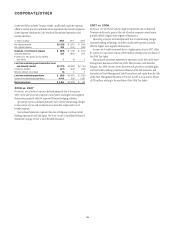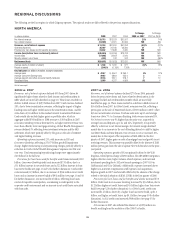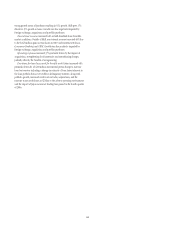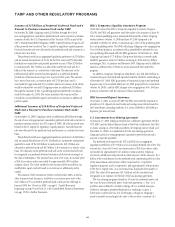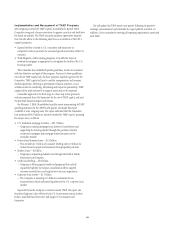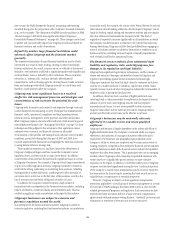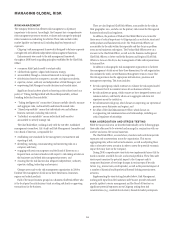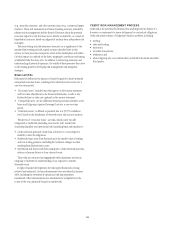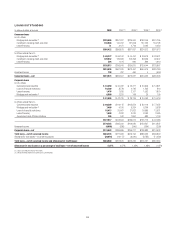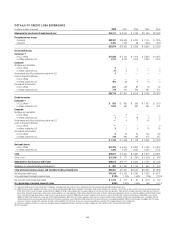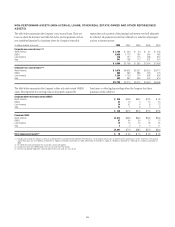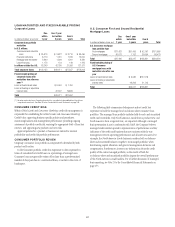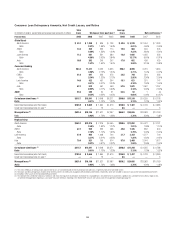Citibank 2008 Annual Report Download - page 54
Download and view the complete annual report
Please find page 54 of the 2008 Citibank annual report below. You can navigate through the pages in the report by either clicking on the pages listed below, or by using the keyword search tool below to find specific information within the annual report.capital markets or trigger obligations under certain bilateral provisions in
some of the Company’s trading and collateralized financing contracts. In
addition, under these provisions, counterparties could be permitted to
terminate certain contracts with Citigroup or require the Company to post
additional collateral. Termination of the Company’s trading and
collateralized financing contracts could cause Citigroup to sustain losses and
impair its liquidity by requiring Citigroup to find other sources of financing
or to make significant cash payments or securities transfers.
Recently enacted legislation authorizing the U.S.
government to take direct action within the financial
services industry, and other legislation and regulation
currently under consideration, may not stabilize the U.S.
financial system in the near term.
On October 3, 2008, the Emergency Economic Stabilization Act of 2008
(EESA) was signed into law. In addition, on February 17, 2009, the American
Recovery and Reinvestment Act of 2009 (ARRA) was signed by President
Obama. The purpose of these U.S. government actions is to stabilize and
provide liquidity to the U.S. financial markets and jumpstart the U.S.
economy. The U.S. government is currently considering, and may consider
in the future, additional legislation and regulations with similar purposes.
The EESA, ARRA and other governmental programs may not have their
intended impact of stabilizing, providing liquidity to or restoring confidence
in the financial markets. Further, the discontinuation and/or expiration of
these or other governmental programs could result in a worsening of current
market conditions.
Citigroup may fail to realize all of the anticipated benefits
of the proposed realignment of its businesses.
On January 16, 2009, Citigroup announced that it would realign into two
businesses, Citicorp and Citi Holdings, for management and reporting
purposes, effective second quarter of 2009. The realignment is part of
Citigroup’s strategy to focus on its core businesses, reduce its balance sheet
and simplify its assets. Citigroup believes this structure will allow it to
enhance the capabilities and performance of Citigroup’s core assets, through
Citicorp, as well as realize value from its non-core assets, through Citi
Holdings. Citi Holdings will also include Citigroup’s 49% interest in the
recently announced Morgan Stanley Smith Barney joint venture, a
transaction which is also intended to simplify and streamline the Company
on a going-forward basis. Despite these efforts, given the rapidly changing
and uncertain financial environment, there can be no assurance that the
realignment of Citigroup’s businesses will achieve the Company’s desired
objectives or benefits.
Future issuance of Citigroup common stock and preferred
stock may reduce any earnings available to common
stockholders and the return on the Company’s equity.
During 2008, Citigroup raised a total of approximately $77.3 billion in
private and public offerings of preferred and common stock and warrants to
purchase common stock, including issuances to the U.S. government under
TARP. While this additional capital provides further funding to Citigroup’s
businesses and has improved the Company’s financial position, it has
increased the Company’s equity and the number of actual and diluted shares
of Citigroup common stock. On February 27, 2009, Citigroup announced an
exchange offer of its common stock for up to $27.5 billion of its existing
preferred securities and trust preferred securities. The U.S. government will
match this exchange up to a maximum of $25 billion of its preferred stock.
These transactions will significantly dilute the existing common stockholders
of the Company. In addition, such increases in the outstanding shares of
common stock reduce the Company’s earnings per share and the return on
the Company’s equity, unless the Company’s earnings increase
correspondingly. Further, any additional future U.S. governmental
requirements or programs could result in or require additional equity
issuances, which further dilute the existing common stockholders and any
earnings available to the common stockholders.
The elimination of QSPEs from the guidance in SFAS 140
and changes in FIN 46(R) may significantly impact
Citigroup’s consolidated financial statements.
The FASB has issued an Exposure Draft of a proposed standard that would
eliminate qualified SPEs (QSPEs) from the guidance in SFAS 140,
Accounting for Transfers and Servicing of Financial Assets and
Extinguishments of Liabilities, and a separate Exposure Draft of a proposed
standard that proposes three key changes to the consolidation model in FIN
46(R). Such changes include the following: (i) former QSPEs would be
included in the scope of FIN 46(R); (ii) FIN 46(R) would be amended to
change the method of analyzing which party to a variable interest entity
(VIE) should consolidate the VIE to a qualitative determination of power
combined with benefits and losses; and (iii) the analysis of primary
beneficiaries would have to be reevaluated whenever circumstances change.
While these proposed standards have not been finalized, they may have a
significant impact on Citigroup’s consolidated financial statements as the
Company may lose sales treatment for assets previously sold to a QSPE, as
well as for future sales, and for transfers of a portion of an asset, and the
Company will be required to bring a portion of assets that are not currently
on its balance sheet onto its balance sheet. For a further discussion on SFAS
140, see “Significant Accounting Policies and Significant Estimates” on page
18 and “Capital Resources and Liquidity—Off-Balance Sheet
Arrangements—Elimination of QSPEs and Changes in the FIN 46(R)
Consolidation Model” on page 104.
Citigroup’s financial statements are based in part on
assumptions and estimates, which, if wrong, could cause
unexpected losses in the future.
Pursuant to U.S. GAAP, Citigroup is required to use certain assumptions and
estimates in preparing its financial statements, including in determining
credit loss reserves, reserves related to litigations and the fair value of certain
assets and liabilities, among other items. If assumptions or estimates
underlying Citigroup’s financial statements are incorrect, Citigroup may
experience material losses. For example, Citigroup makes judgments in
connection with its consolidation analysis of its SPEs. If it is later determined
that non-consolidated SPEs should be consolidated, this could adversely
affect Citigroup’s consolidated balance sheet, related funding requirements
and capital ratios, and, if the SPE assets include unrealized losses, could
require Citigroup to recognize those losses see “Significant Accounting
Policies and Significant Estimates” on page 18.
Changes in accounting standards can be difficult to predict
and can materially impact how Citigroup records and
reports its financial condition and results of operations.
Citigroup’s accounting policies and methods are fundamental to how it
records and reports its financial condition and results of operations. From
48


